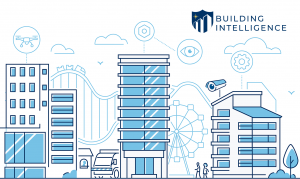Shaping the Workplace with Smart Building Features
Smart cities comprise a broad range of features, but Information Handling Services (IHS) uses the term to describe cities that have deployed or are currently piloting the integration of information, communications, and technology (ICT) solutions across three or more different functional areas of a city.
Smart city tech deployments are on the rise, particularly in commercial buildings. Connected building solutions offer cost savings and increased efficiency through automation of areas like visitor management, security systems, environmental controls, energy conservation, and communications interfaces. Building managers tasked with maximizing operational and energy efficiency are increasingly adopting smart building technology to update infrastructure and improve the building’s environment for occupants.
As smart building deployments increase, some key elements are expected to evolve and gain widespread adoption over the next year.
Improved Operational Efficiency in Smart Building Upgrades
Improved operational efficiency will be a major focus in upgrading legacy building systems and assets. Instead of taking a costly “rip and replace” approach, building managers can utilize technology solutions that can be retrofit to existing systems with sensors and securely transfer asset data to the cloud. Smart buildings also deliver operational benefits including improved uptime of equipment and product loss prevention.
Building Management will Become More Autonomous with Emerging Technologies
Machine Learning and 5G connectivity will emerge and interact to transform building management into a more self-sustained task.
Machine learning enables buildings systems to collect and process information from the systems to deliver actionable insight in real-time, which building managers can use to make quick decisions about maintenance and overall operations. 5G connectivity enables a more advanced data exchange between smart buildings, which will play a significant role in laying the foundation for smart cities in the future.
Reducing Buildings’ Carbon Footprint
Adoption of smart building technology will continue to be driven by ambitious sustainability goals, Reducing a property’s carbon footprint necessitates both close monitoring and actionable data insights on the building’s energy and water use. Information gathered by networked sensors and analytics will enable building managers to better control their assets and reduce energy waste that can harm the environment.
Providing Customizable Occupant Environments for Added Value
As people increasingly adopt a connected lifestyle, demand for more stable building environments that provide customizable surroundings based on occupant preferences will continue to rise. For example, smart technology that allows tenants to easily adjust room temperature settings or quickly find an available conference room using a supporting app is already experiencing a rise in demand. The applications for smart technologies are endless, and the ability to offer such personalized options will add value for smart building managers looking to attract and retain tenants.
To learn more about how to bring smart building features to your office, contact us today at 1-888-718-0807. If you’d like to see a demo of our software, we can schedule one for you today.



